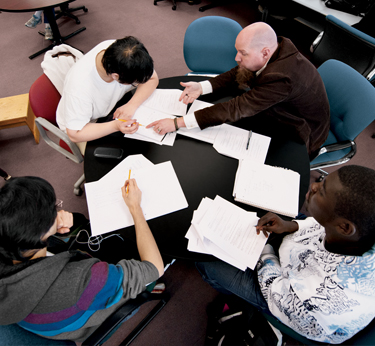Classroom Revolution

Revolutionary heroes (from left to right): Michael Mills, John Hamman, Emily Rosado, and Virginia Miller are testing the waters with MOOCs—massive open online courses—and innovative instructional methods.
Welcome to the bold new classroom, where students attend lectures at home, and do their homework in class.
“The days of lecturing are long gone,” said Dr. Michael Mills, the College’s director of distance education and learning and interim director of the Center for Teaching and Learning. “Students don’t respond to that. They’re coming to us with a different style of learning. And we’re meeting them halfway with the technology and tools they expect.”
Mills and his staff work hand in hand with MC faculty to help them to harness the power of cutting-edge technology, the goal of which is to ensure greater student engagement and learning.
Flipping Out
Professor John Hamman is chair of the Mathematics Department at Germantown and 2012 Maryland Professor of the Year, an honor conferred by the Carnegie Foundation for the Advancement of Teaching and the Council for the Advancement and Support of Education. Today, he is breaking new ground by providing his Calculus I students a modified version of a massive open online course, or MOOC, offered by the Massachusetts Institute of Technology (MIT).
A MOOC differs from a traditional online course in that it is usually free, noncredit, and features massive enrollment.
The medium is still the lecture, and adapting to shorter attention spans of today’s students, the lectures are brief, maybe eight to 12 minutes. The videos pause for quizzes to make sure students understand the material. Feedback is electronic, and students interact via online forums.

Photo: Sanjay Suchak
The big payoff? The textbook is available for free online, a savings of about $240. Just as important, Hamman said, “Students learn at their own pace. They can absorb the material in bite-size chunks. They can review the whole lecture if they didn’t get it the first time.”
His experience thus far has been positive. “The students like the fact that they see problems worked out online. The class ‘gets’ the content about 60 percent of the time. Then we talk about it in class. Then they go back and watch the lecture a second time. That really embeds learning. They’re putting in more time. They’re more engaged. This is active, rather than passive learning and understanding.”
And, he added, “They learn a ton because they’re working with a partner. They understand it so much better from another student. Doing homework with a partner turns on a little light bulb and [transforms the process] into a learning experience.”
Travis Miller, who is taking Hamman’s course, likes the new approach because it enables the class to spend more time working through problems, rather than spending most of the time with lecture notes and instruction.
The group work not only helps him interact with others in the class, but also pushes critical thinking and problem solving.
“This has proven to help everyone by providing opportunities for students to teach others who many not grasp the material as well, thus reinforcing the material,” said Miller. “It also adds variety, which is invaluable in keeping everyone alert and engaged with the topic at hand.”
A Catalyst for Learning
Hamman is not the only professor running a flipped classroom. Several physics and chemistry professors have signed on, including Chemistry Professor Virginia Miller, who helped pilot a redesigned Chemistry 101 course for several sections in fall 2011 and spring 2012.
Traditional Chemistry 101 classes feature a lecture-style approach in which instructors use PowerPoint presentations, “chalk talks,” and in-class demonstrations. In the flipped course, the time associated with lecture is replaced by group work, instructional activities, and mini “power lectures” given by the professor.
Students learn the basic concepts at home via study guides, video tutorials, and quizzes. They spend class time working in groups to engage in various activities and complete problem solving and worksheets. No longer is there a distinction between lecture time and discussion time.
“This is literally changing the way students learn,” said Miller, who admitted she was skeptical at first. “You’re giving up what you are comfortable with—lecturing—and turning [the responsibility for learning] over to the students. Now I really enjoy it. Moving to a flipped classroom, with its focus on group activities, makes all the difference.”
Results are encouraging. Students who participated in redesigned sections of Chemistry 101 scored higher on the common final exam than those students who were taught in a traditional lecture format.
Student response to the flipped class was overwhelmingly positive: 98 percent strongly agreed that the course increased their ability to solve problems. And nearly 99 percent of them said they would recommend the redesigned course to a friend.
“This way of learning was beneficial for me,” said nursing student Daniela Garau ’13. “I was able to freely ask questions of my peers and, if I didn’t trust an answer, Professor Miller was available to help. I also liked working in small groups; other students would understand a concept and then explain it in a different way that made more sense to me. Chemistry is a difficult course, and you have to consistently practice and work at it to do well. The flipped method worked for me.”
Her classmate, Mana Shoeybi ’13, agreed: “The remarkable benefit of this method to me was the dynamic atmosphere of the class, which made me more eager to participate.”
Boosting College Readiness
Capitalizing on the potential of the MOOC to reach huge audiences, Mills and English Professor Emily Rosado are creating a new Montgomery College MOOC, “Get Ready for College English.”
The MOOC, which will launch this fall, offers free, online instruction for students who either have weak writing skills or who have been away from the school setting. The goal is to prepare students to test into a college-level English course, and to increase access for students who aren’t able to pay for a review course or a developmental (noncredit) course.
“Students who place into developmental courses have a low completion rate,” said Rosado, noting that college-level English is a prerequisite for virtually all credit-bearing courses. “This MOOC will hopefully bridge the gap and prepare the student to enroll in college-level English.”
Students will learn via short (8–10 minute) video lectures, peer-to-peer online interaction, interactive discussion board assignments, and instructor feedback.
“Peer assessment will be critical in providing feedback to students, as this course is truly ‘open’ and could potentially enroll hundreds or thousands of students,” said Rosado.
Rosado and Mills plan to use a host of newer technologies in the MOOC, including Prezi, which Mills described as “PowerPoint on steroids”; Jing, a program that allows you to record voice comments to a file; and videos created with the help of the production staff from Montgomery College Television.
“We are treading new ground here, as most of the MOOCs are currently offered by big name universities such as Harvard and Duke,” said Rosado.
—Tina Kramer
This article first appeared in the spring 2013 issue of Insights.


